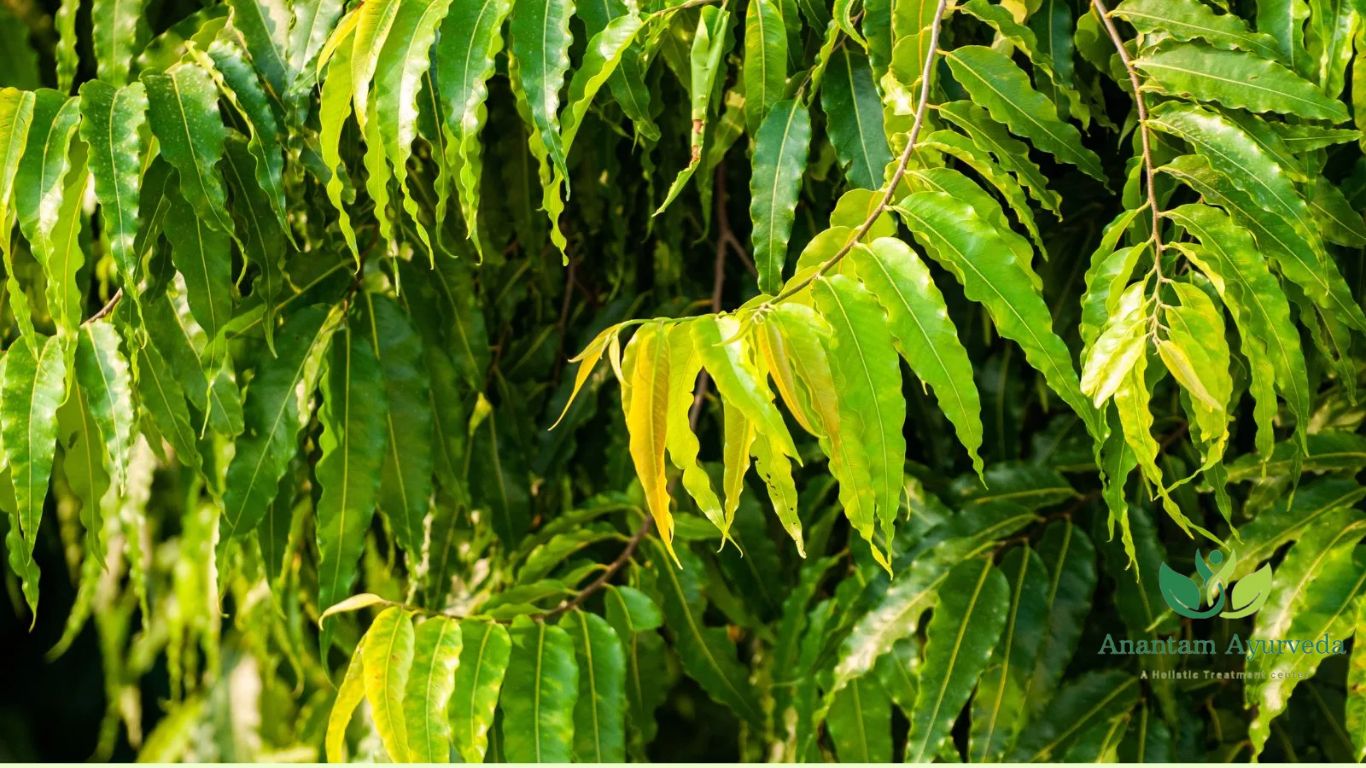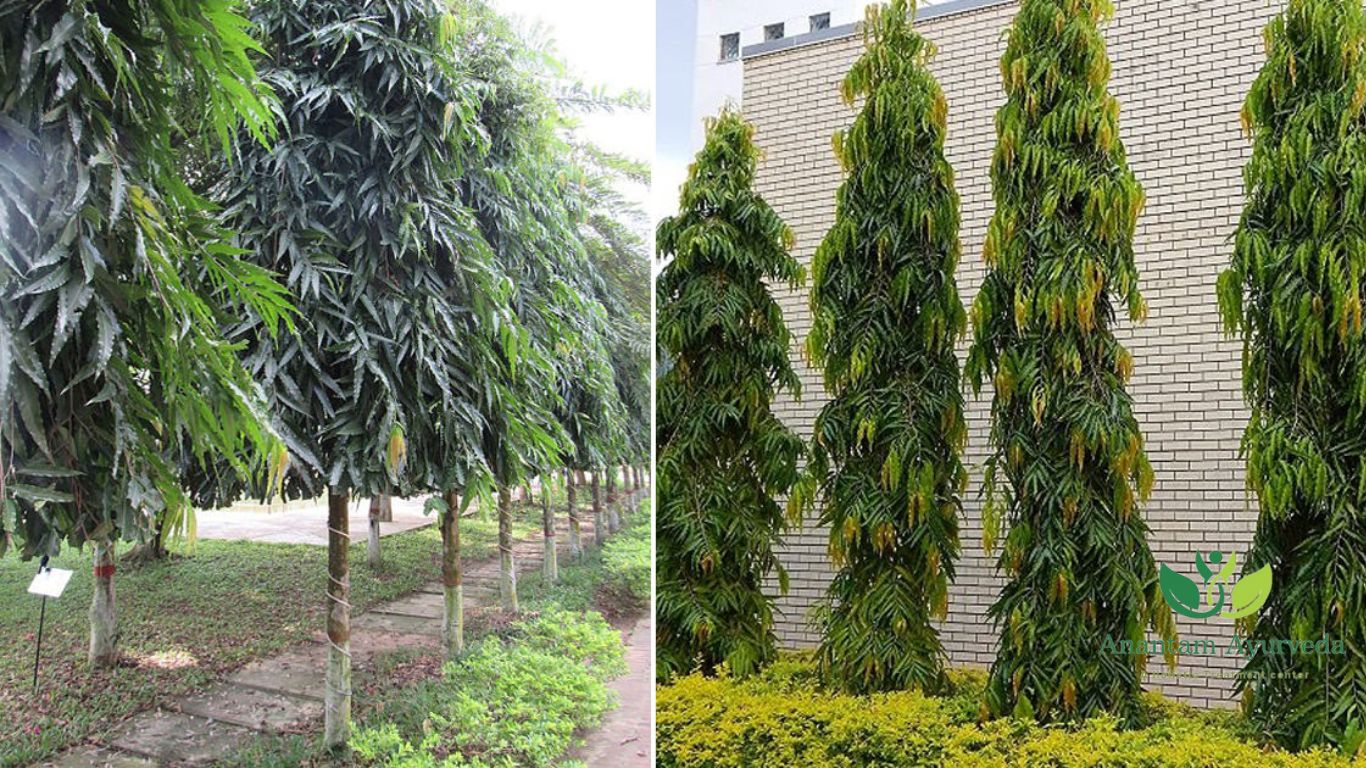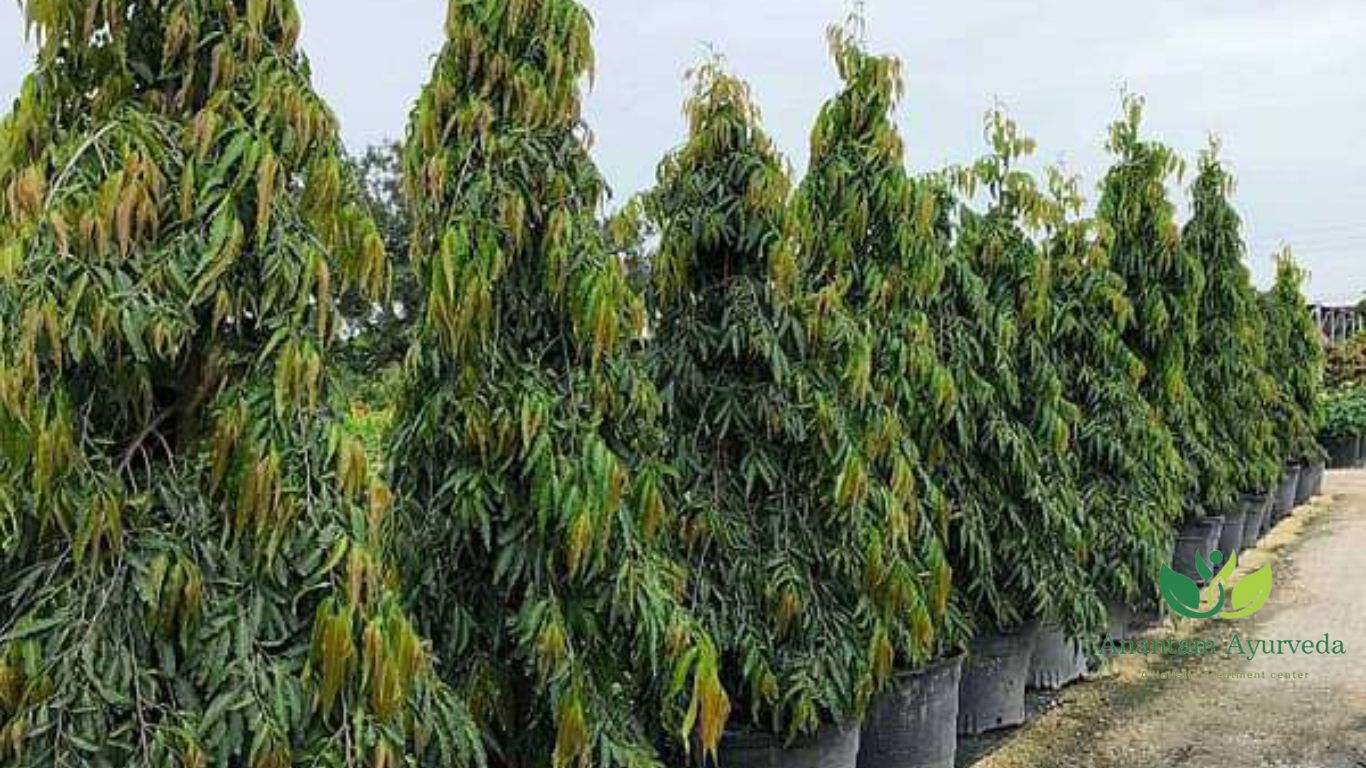Ashoka Tree (Saraca asoca): Ashoka Tree Uses
Introduction
Ashoka Tree (Saraca asoca) is one of the most revered medicinal plants in Ayurveda, known for its remarkable health benefits, particularly in gynecological disorders. The name ‘Ashoka’ translates to ‘remover of sorrow,’ reflecting its potent therapeutic properties in alleviating physical and emotional distress.

Vernacular Names Ashoka Tree
- Hindi: Ashoka
- Tamil: Ashogam
Sanskrit Synonyms Ashoka Tree
- Ashoka – ‘Shoka’ means grief; Ashoka means one that relieves pain and grief of women.
- Hemapushpa – Flowers of golden color.
- Tamrapallava – Tender leaves have a coppery red color.
- Stripriya – Useful in Striroga (women’s health disorders).
- Kamkeli – It generates happiness.
- Madhupushpa – The plant flowers in Vasanta Ritu (spring season).
- Pinda Pushpa – Inflorescence is globose.
- Ganda Pushpa – Flowers are aromatic.
Botanical Classification Ashoka Tree
-
Kingdom – Plantae
-
Subkingdom – Tracheobionta
-
Superdivision – Spermatophyta
-
Division – Magnoliophyta
-
Class – Magnoliopsida
-
Subclass – Rosidae
-
Order – Fabales
-
Family – Leguminosae
-
Subfamily – Caesalpinaceae
-
Genus – Saraca
-
Species – Asoca / Indica
Habitat & Distribution Ashoka Tree
Ashoka is native to India and commonly found in tropical rainforests. It is widely distributed in:
-
India: Bengal, Karnataka, Kerala, Maharashtra, Andhra Pradesh, Meghalaya, and the Western Ghats
-
Other regions: Central & Eastern Himalayas, Khasi, Garo, and Lushai Hills
Morphology of Ashoka Tree
-
Height – 6 to 9 meters (can reach up to 30 feet)
-
Branches – Glabrous (smooth and hairless)
-
Leaves – 15-20 cm long, compound with short petioles
-
Inflorescence – Axillary corymb
-
Flowers – Fragrant, bisexual, orange-red in color, with 7-8 stamens in bunches
-
Fruit – Black, smooth, leathery, and flat pods (12-20 cm long, 5 cm wide)
-
Seeds – 4-8 per pod, ellipsoid-oblong, slightly compressed
Note: Ashoka is often confused with Kashtadaru (Polyalthia longifolia), an ornamental tree, but they are different species.
 Classical Categorization in Ayurveda
Classical Categorization in Ayurveda
-
Charaka Samhita: Kashayaskandha (Astringent-tasting herbs), Vedanasthapana (Pain-relieving herbs)
-
Sushruta Samhita: Lodhradigana
-
Vagbhata: Rodhradi Varga
Ayurvedic Properties of Ashoka Tree
| Property | Description |
|---|---|
| Guna (Qualities) | Laghu (Light to digest), Rooksha (Dry) |
| Rasa (Taste) | Kashaya (Astringent), Tikta (Bitter) |
| Vipaka (Post-digestive effect) | Katu (Pungent) |
| Veerya (Potency) | Sheeta (Cold) |
| Effect on Doshas | Balances Kapha and Pitta |
Chemical Composition of Ashoka
-
Bark: Tannins, Haematoxylin, Flavonoids, Steroids, Saponins, Volatile oils, Catechol, Iron, Glycosides
-
Leaves: Carbohydrates, Tannins, Gallic acid, Egallic acid
-
Flowers: Saracasin, Saracadin, Waxy substances, Proteins, Steroids
-
Seeds: Fatty acids (Oleic, Linoleic, Palmitic, Stearic acid)
Pharmacological Actions
-
Astringent – Tightens tissues and reduces excessive secretions
-
Uterine Sedative – Supports uterine health and relieves menstrual disorders
Parts Used
-
Stem bark – Most commonly used part
-
Seeds
-
Flowers
Dosage & Preparations:
| Form | Dosage |
|---|---|
| Kwatha (Decoction) | 40 – 80 ml |
| Bija Churna (Seed Powder) | 1 – 3 g |
| Pushpa Churna (Flower Powder) | 1 – 3 g |
Medicinal Qualities of Ashoka Tree
Ashoka is famous for its analgesic, styptic-hemostatic, tranquilizing, anti-dyspeptic, and diuretic properties.
Therapeutic Indications
Ashoka is beneficial in the treatment of:
- Pradara (Excessive menstrual bleeding)
- Yonivyapat (Gynecological disorders)
- Trisna (Excessive thirst)
- Daha (Burning sensation)
- Gulma (Abdominal lump/tumor)
- Visaghna (Detoxifying effect)
- Stambhaka (Astringent, stops excessive fluid loss)
- Vranaropaka (Wound healing)
- Hridya (Cardiac tonic)

Pharmacological and Therapeutic Benefits of Ashoka Tree
- Gynecological Health
- Ashoka is widely known for its ability to balance female reproductive health.
- It is beneficial in conditions like menorrhagia (heavy menstrual bleeding), dysmenorrhea (painful menstruation), leucorrhea, and other uterine disorders.
- Used in classical formulations such as Ashokarishta, which is prescribed for menstrual irregularities.
- Anti-inflammatory and Analgesic Properties
- Due to its astringent and cooling properties, Ashoka reduces inflammation and pain.
- Effective in treating conditions like arthritis and joint disorders.
- Skin and Wound Healing
- Ashoka bark extract has antibacterial and antifungal properties, making it useful for skin infections, ulcers, and wound healing.
- Digestive Health
- Helps in managing diarrhea and dysentery due to its astringent properties.
- Promotes liver health by supporting digestion and detoxification.
- Cardiovascular Support
- It is beneficial in improving circulatory function and reducing stress-related heart issues.
- Supports healthy blood pressure levels.
- Mental Well-being
- Traditionally used to reduce anxiety, depression, and stress.
- Promotes mental clarity and emotional stability.

Home Remedies Using Ashoka Tree
-
Ashoka for Regulating Heavy Menstrual Flow
-
Boil 10 grams of Ashoka bark in 2 cups of water until it reduces to half.
-
Strain and consume on an empty stomach twice a day.
-
Add a teaspoon of honey or jaggery if desired.
-
Helps in reducing heavy menstrual flow.
-
-
Ashoka for Balancing Bleeding Disorders & Irregular Cycles
-
Combine equal parts of Ashoka, Yashtimadhu (Indian Licorice), and Lajjalu (Touch-me-not).
-
Mix 1 tablespoon of this powder in 2 cups of water, boil until reduced to half.
-
Start taking 3-5 days before your period and continue for 10 days after.
-
Balances irregular cycles and manages bleeding disorders.
-
-
Ashoka Bark Decoction for Wound Healing
-
Prepare an Ashoka bark decoction.
-
Use it for washing wounds and non-healing ulcers.
-
Promotes healing and reduces infection risks.
-
-
Ashoka Flower Chutney for Digestive Health
-
Blend a handful of Ashoka flowers with a bit of coconut pulp.
-
Add salt, black pepper, curry leaves, and coriander to taste.
-
Helps treat gastritis, mouth ulcers, and GERD.
-
-
Ashoka Bark for Treating Leucorrhea
-
Grind equal amounts of Ashoka bark, Amalaki fruit rind, and Nagakesar stamens (Mesua ferrea).
-
Mix 1-2 grams of this powder with rice-washed water or sweet buttermilk.
-
Consume twice daily for treating leucorrhea and gastric regurgitation.
-
Ayurvedic Formulations Containing Ashoka
- Ashokarishta: A widely used Ayurvedic tonic for menstrual and gynecological disorders.
- Ashoka Ghrita: A herbal ghee preparation useful in reproductive and hormonal imbalances.
- Decoction of Ashoka Bark: Used traditionally for treating heavy menstruation and uterine disorders.
Usage and Dosage
- Ashokarishta: 15-30 ml with equal amounts of water, twice a day after meals.
- Ashoka Bark Powder: 3-6 grams per day with warm water or honey.
- Decoction: Prepared by boiling Ashoka bark in water, consumed for gynecological benefits.
Contraindications and Precautions
- Should be used under medical supervision, especially for pregnant or lactating women.
- Excessive consumption may cause constipation due to its astringent nature.
- Not recommended for individuals with chronic gastric irritation.
Conclusion
Ashoka (Saraca asoca) remains one of the most essential herbs in Ayurveda, particularly for female reproductive health. Its anti-inflammatory, analgesic, and astringent properties make it a valuable herb for various health conditions beyond gynecology. Integrating Ashoka into Ayurvedic treatments can help promote overall well-being while maintaining the balance of doshas (Vata, Pitta, and Kapha). However, it is always advisable to consult an Ayurvedic practitioner before using Ashoka-based formulations to ensure proper dosage and efficacy.

Frequently Asked Questions (FAQs) on Ashoka (Saraca asoca)
How long can Ashoka bark be stored?
Ashoka bark maintains its effectiveness for up to 3 years when stored in optimal conditions. This longevity ensures its continued use for medicinal purposes over time.
Can Ashoka lead to early menopause?
There is no scientific evidence linking Ashoka to early menopause. Its astringent and antihemorrhagic properties help regulate menstrual health and support uterine function without triggering premature menopause.
Is Ashoka beneficial for treating diarrhea?
Can Ashoka help with piles?
While scientific research is limited, Ashoka is traditionally known for its ability to alleviate symptoms of piles, such as bleeding and pain. Its cooling and anti-inflammatory properties help soothe the condition, providing relief from swelling and discomfort.
Is Ashoka helpful for tumors?
Ashoka has shown potential in preventing tumor growth, particularly in skin cancer, due to its flavonoids, which inhibit enzymes responsible for tumor formation. Its antioxidant and anti-inflammatory properties also play a role in reducing the risk of tumor development.
Are Ashoka tree leaves effective for treating Swine flu?
There is no scientific backing for using Ashoka tree leaves as a treatment for Swine flu. However, herbs like Aloe Vera, Giloy, and Ashwagandha are known to support the immune system and manage viral infections. Ashoka may complement such remedies with its fever-reducing and immune-boosting properties.
What are the benefits of Ashoka powder?
Ashoka powder offers a range of health benefits, including supporting menstrual health by reducing irregular periods, cramps, and pain. It also helps in managing infections, reducing inflammation, alleviating pain, and improving skin health. The powder is packed with antioxidants that help detoxify the body and fight off oxidative stress.
Does Ashoka help control blood sugar?
Can Ashoka be used to treat acne and other skin problems?
Due to its antimicrobial and anti-inflammatory properties, Ashoka is effective in treating acne, skin infections, and other inflammatory skin conditions. It helps reduce redness and prevent bacterial growth, contributing to clearer skin.
Are there any side effects of Ashoka?
Is Ashoka safe to use during pregnancy?
Can Ashoka help lower blood pressure?
Ashoka has been noted for its potential to help lower blood pressure, though those with already low blood pressure should exercise caution. It’s important to consult a healthcare provider before using Ashoka in such cases.
How can Ashoka be consumed for medicinal benefits?
Ashoka can be consumed in various forms, such as powder, decoction, or as part of herbal formulations. It’s important to follow proper dosages and seek medical advice to ensure its effectiveness and safety.
How do you cultivate an Ashoka tree?
The Ashoka tree can be cultivated in well-draining soil with partial sunlight. Regular watering and occasional pruning promote healthy growth. It’s an excellent choice for adding greenery to gardens while also providing medicinal benefits.
Can Ashoka interact with other medications?
Ashoka may interact with certain medications, especially those for blood pressure or blood sugar regulation. Always consult with a healthcare provider before incorporating Ashoka into your routine, particularly if you’re on medication.
Is Ashoka safe for children?
There is limited information on the safety of Ashoka for children. It’s best to consult with a pediatrician before introducing Ashoka to a child’s diet or health regimen.
Can Ashoka be used to treat urinary problems?
Does Ashoka have anti-inflammatory properties?
Can Ashoka help with respiratory issues like asthma?
How should Ashoka be used for menstrual problems?
Ashoka is commonly useful in powder or decoction form to regulate menstrual cycles, alleviate cramps, and reduce excessive bleeding. Always consult with a healthcare provider to determine the best dosage for individual needs.
By understanding Ashoka’s benefits and uses, you can harness its natural healing properties while ensuring its safe and effective application.
You can also read about Dengue.
You can follow us on twitter, facebook, instagram & Google News

1 Comment